INSTITUT SUPERIEUR D'ANTHROPOLOGIE
INSTITUTE OF ANTHROPOLOGY
ONLINE COURSES / COURS A DISTANCE
SPRING TERM : APRIL 2014
REGISTER NOW
INDE – 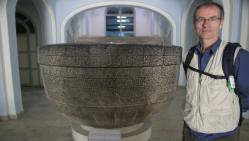 Vaishali,-Two Indian archaeologists are being sent to Kabul to study a "begging bowl" thought to have been used by Buddha in a first step to bringing the artifact back to India, an official said. The huge stone vessel, weighing nearly 400 kilograms (880 pounds), is currently displayed at the National Museum of Afghanistan and is regarded as important in the Buddhist religion.The ASI says its historical documents and research suggests that Buddha donated the bowl, which is 1.75 metres (5.7 feet) in diameter, to the people of Vaishali, a Buddhist pilgrimage site in the eastern Indian state of Bihar. A king who ruled northern India and other parts of Asia in the second century took the bowl to what is now Peshawar in Pakistan, before being moved to what is now Kandahar in Afghanistan, ASI says its research shows. The bowl was then believed to have been moved to the Kabul museum during the Soviet war in Afghanistan in the 1980s.he greenish-grey granite bowl has a lotus flower chiseled around its base, suggesting its Buddhist past. The bowl was later inscribed along its rim with rows of Arabic verses from the Koran.
Vaishali,-Two Indian archaeologists are being sent to Kabul to study a "begging bowl" thought to have been used by Buddha in a first step to bringing the artifact back to India, an official said. The huge stone vessel, weighing nearly 400 kilograms (880 pounds), is currently displayed at the National Museum of Afghanistan and is regarded as important in the Buddhist religion.The ASI says its historical documents and research suggests that Buddha donated the bowl, which is 1.75 metres (5.7 feet) in diameter, to the people of Vaishali, a Buddhist pilgrimage site in the eastern Indian state of Bihar. A king who ruled northern India and other parts of Asia in the second century took the bowl to what is now Peshawar in Pakistan, before being moved to what is now Kandahar in Afghanistan, ASI says its research shows. The bowl was then believed to have been moved to the Kabul museum during the Soviet war in Afghanistan in the 1980s.he greenish-grey granite bowl has a lotus flower chiseled around its base, suggesting its Buddhist past. The bowl was later inscribed along its rim with rows of Arabic verses from the Koran.
http://www.hurriyetdailynews.com/india-eyes-return-of-buddha-begging-bowl-from-afghanistan.aspx?pageID=238&nID=61028&NewsCatID=375
NEPAL -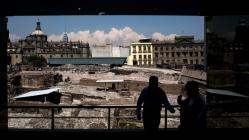 Tilaurakot - A team of archaeologists and experts have started excavation work at Tilaurakot, an ancient Shakya capital city, where Siddhartha spent 29 years of his princely life before he became Gautam Buddha. Around two months ago, the team had discovered proofs of Budhha’s birth in sixth century BC, two centuries earlier than previously thought. The archaeologists said the excavation aims at giving Tilaurakot a facelift, precisely to provide a view of an ancient city. The city of Tailaurakot had caught the eyes of the archaeologists after a recent geological survey conducted in the area substantiated that there might be remains of an ancient city underneath, prompting the archaeologists to start the excavation. The excavation has been divided into three sites. The team has started excavation 10 metres to the fore of the remains of the western gate of the palace of king Shudhodan, the father of Lord Buddha. The fact that there were underground tunnels beneath the western gate suggested that there might be buildings on either side, said the experts. Likewise, the second site is a trail located 30 metres from the palace. As they had found two huge brick remains above the ground in the area spanning 10-15 metres, the excavation would be conducted by digging a trench. The team has also started fresh excavations in the north-western wall of the palace fort. Dewala Mitra, an Indian archaeologist, had conducted excavation in the area in 1962, and a team of Nepali archaeologists had found a post hole (a cut feature used to hold a surface timber or stone) three and a half feet under the ground last year. A member of the excavation team, senior archaeologist and Unesco consultant, Kosh Prasad Acharya, said the discovery of the post hole at such depth proves the ancient significance of Tilaurakot. Acharya said that they would re-examine the area by digging one foot deeper spanning five to six metres on the eastern side. The team has brought in Prof Dr Ian Simpson, specialist of Stirling University, to examine the sand of the area where the post hole was found. Prof Dr Robin Coningham, chief archaeologist of the Durham University, said that the excavation would furnish invaluable insight into the aeon of Tilaurakot and bring into view the architecture of the ancient city. Coningham added that along with the excavation, the team will be mapping the adjoining areas of Kanthak, Dhamanihawa (the site believed to be the tombs of Mayadevi and Shudhodan, and Lohsariya Stupa for their preservation.
Tilaurakot - A team of archaeologists and experts have started excavation work at Tilaurakot, an ancient Shakya capital city, where Siddhartha spent 29 years of his princely life before he became Gautam Buddha. Around two months ago, the team had discovered proofs of Budhha’s birth in sixth century BC, two centuries earlier than previously thought. The archaeologists said the excavation aims at giving Tilaurakot a facelift, precisely to provide a view of an ancient city. The city of Tailaurakot had caught the eyes of the archaeologists after a recent geological survey conducted in the area substantiated that there might be remains of an ancient city underneath, prompting the archaeologists to start the excavation. The excavation has been divided into three sites. The team has started excavation 10 metres to the fore of the remains of the western gate of the palace of king Shudhodan, the father of Lord Buddha. The fact that there were underground tunnels beneath the western gate suggested that there might be buildings on either side, said the experts. Likewise, the second site is a trail located 30 metres from the palace. As they had found two huge brick remains above the ground in the area spanning 10-15 metres, the excavation would be conducted by digging a trench. The team has also started fresh excavations in the north-western wall of the palace fort. Dewala Mitra, an Indian archaeologist, had conducted excavation in the area in 1962, and a team of Nepali archaeologists had found a post hole (a cut feature used to hold a surface timber or stone) three and a half feet under the ground last year. A member of the excavation team, senior archaeologist and Unesco consultant, Kosh Prasad Acharya, said the discovery of the post hole at such depth proves the ancient significance of Tilaurakot. Acharya said that they would re-examine the area by digging one foot deeper spanning five to six metres on the eastern side. The team has brought in Prof Dr Ian Simpson, specialist of Stirling University, to examine the sand of the area where the post hole was found. Prof Dr Robin Coningham, chief archaeologist of the Durham University, said that the excavation would furnish invaluable insight into the aeon of Tilaurakot and bring into view the architecture of the ancient city. Coningham added that along with the excavation, the team will be mapping the adjoining areas of Kanthak, Dhamanihawa (the site believed to be the tombs of Mayadevi and Shudhodan, and Lohsariya Stupa for their preservation.
https://www.ekantipur.com/2014/01/14/headlines/Fresh-excavation-begins-at-Tilaurakot/383852/
GUADELOUPE – Raisins Clairs - L’érosion marine sur le littoral de Saint-François détruit progressivement un cimetière d’époque coloniale sur la plage des Raisins Clairs. Dans un souci de sauvegarde du patrimoine, le service de l’Archéologie de la direction des Affaires culturelles (Dac) de Guadeloupe a prescrit une fouille préventive, financée par l’État, le Conseil régional de la Guadeloupe et la ville de Saint-François ; elle sera réalisée par l’Inrap du 13 janvier au 12 février 2014.
http://www.caraibcreolenews.com/communiques,1,6143,guadeloupe-fouille-archy-ologique-pry-ventive-sur-la-plage-des-raisins-clairs.html
DANEMARK – 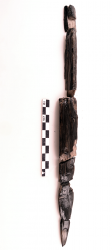 Rødbyhavn - Les pays du nord de l’Europe sont bien connus en archéologie pour les découvertes exceptionnelles réalisées en milieux humides. Outre les artefacts en silex, en ambre, en os, nombreux sont les artefacts en matériaux périssables ayant traversé les millénaires : en bois (par exemple l’arc de Holmegårds Mose, le plus vieil arc connu au monde) , en textiles, et même des tresses de cheveux! Vous pouvez avoir un petit aperçu de ces découvertes sur le site du Musée National de Copenhague. Les fouilles préventives en cours près de Rødbyhavn, dans le sud du Lolland ne font pas exception : des découvertes exceptionnelles y sont réalisées. Une équipe d’archéologues danois, allemands et néerlandais y réalise une importante campagne de sondage depuis mai 2013 (elle devrait prendre fin en 2015) : plus de 1000 sondages sont prévus afin d’apporter un éclairage nouveau sur le passé du Lolland. Ce chantier, mené par le Museum Lolland-Falster couvre une surface de 180 hectares. La zone sera ensuite aménagée pour recevoir des infrastructures facilitant la traversée du Fehmarnbelt, le détroit séparant le Lolland de l’Allemagne. Bien que les sondages et la campagne de fouilles ne mettent pas l’accent sur une période particulière, les découvertes néolithiques sont prometteuses. D’une part, il s’agit d’une des périodes les mieux représentées dans la région ; d’autre part, la zone sondée a été alternativement émergée et sous eaux permettant des épais dépôts de sable scellant les couches archéologiques.
Rødbyhavn - Les pays du nord de l’Europe sont bien connus en archéologie pour les découvertes exceptionnelles réalisées en milieux humides. Outre les artefacts en silex, en ambre, en os, nombreux sont les artefacts en matériaux périssables ayant traversé les millénaires : en bois (par exemple l’arc de Holmegårds Mose, le plus vieil arc connu au monde) , en textiles, et même des tresses de cheveux! Vous pouvez avoir un petit aperçu de ces découvertes sur le site du Musée National de Copenhague. Les fouilles préventives en cours près de Rødbyhavn, dans le sud du Lolland ne font pas exception : des découvertes exceptionnelles y sont réalisées. Une équipe d’archéologues danois, allemands et néerlandais y réalise une importante campagne de sondage depuis mai 2013 (elle devrait prendre fin en 2015) : plus de 1000 sondages sont prévus afin d’apporter un éclairage nouveau sur le passé du Lolland. Ce chantier, mené par le Museum Lolland-Falster couvre une surface de 180 hectares. La zone sera ensuite aménagée pour recevoir des infrastructures facilitant la traversée du Fehmarnbelt, le détroit séparant le Lolland de l’Allemagne. Bien que les sondages et la campagne de fouilles ne mettent pas l’accent sur une période particulière, les découvertes néolithiques sont prometteuses. D’une part, il s’agit d’une des périodes les mieux représentées dans la région ; d’autre part, la zone sondée a été alternativement émergée et sous eaux permettant des épais dépôts de sable scellant les couches archéologiques.
Parmi les artefacts mis au jour, mentionnons l’extrémité d’un arc, une flèche, une nasse à poissons, un fragment de pagaie,…
http://www.minesdespiennes.org/blog/2014/danemark-des-artefacts-neolithiques-extremement-bien-preserves-a-rodbyhavn/
FRANCE – 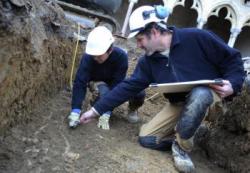 Auch - La cour du cloître de l’ancien couvent des cordeliers n’est qu’un tas de gravats et de terre. Dans deux fosses, casques sur la tête, les archéologues de l’INRAP mesurent, prélèvent, grattent. La dalle qui sert de terrasse au restaurant L’Italien est brisée, et en dessous, préservé, réapparaît le passé de la ville. «Il s’agit d’un diagnostic archéologique, explique Olivier Dayrens, le scientifique en charge de la mission qu’il mène avec l’archéologue architecte Catherine Viers. Comme la terrasse qui est au-dessus des vestiges n’a pas de fondations, tout est resté intact.» Le diagnostic va étudier cette semaine encore la salle capitulaire, après le cloître. Les petites pelleteuses ont pratiqué deux larges excavations. Dans l’une on découvre un long caniveau recouvert de lourdes dalles. «Ce caniveau est postérieur à une cuve, recouverte d’un mortier hydraulique. On ne sait pas de quand date la cuve, Moyen âge ou antiquité… Elle était alimentée par 4 gouttières, toujours en charge.» Les archéologues ont aussi fait d’autres découvertes. De nombreux Auscitains sont enterrés sous l’ancien jardin du cloître. «On a découvert des squelettes d’enfants très jeunes, environ 3 ans, ou de jeunes adultes. Des morts placés dans des cercueils, on a retrouvé les clous.» Dans la 2e fosse, qui se termine sur un mur dont l’utilisation reste inconnue, des ossements bruns. «Il s’agit d’un jeune adulte, sans doute de l’époque médiévale si on se réfère à des tessons retrouvés avec lui. Les enfants retrouvés datent plutôt du XVIIIe siècle.» Les restes du couvent, un bâtiment du XIVe siècle mais remanié au XVIIe, pourraient dévoiler d’autres surprises : les fouilles sonderont la salle capitulaire, où les archéologues s’attendent à trouver de nouvelles sépultures. Et en raconter un peu plus sur l’histoire de la ville avant de refermer les fosses.
Auch - La cour du cloître de l’ancien couvent des cordeliers n’est qu’un tas de gravats et de terre. Dans deux fosses, casques sur la tête, les archéologues de l’INRAP mesurent, prélèvent, grattent. La dalle qui sert de terrasse au restaurant L’Italien est brisée, et en dessous, préservé, réapparaît le passé de la ville. «Il s’agit d’un diagnostic archéologique, explique Olivier Dayrens, le scientifique en charge de la mission qu’il mène avec l’archéologue architecte Catherine Viers. Comme la terrasse qui est au-dessus des vestiges n’a pas de fondations, tout est resté intact.» Le diagnostic va étudier cette semaine encore la salle capitulaire, après le cloître. Les petites pelleteuses ont pratiqué deux larges excavations. Dans l’une on découvre un long caniveau recouvert de lourdes dalles. «Ce caniveau est postérieur à une cuve, recouverte d’un mortier hydraulique. On ne sait pas de quand date la cuve, Moyen âge ou antiquité… Elle était alimentée par 4 gouttières, toujours en charge.» Les archéologues ont aussi fait d’autres découvertes. De nombreux Auscitains sont enterrés sous l’ancien jardin du cloître. «On a découvert des squelettes d’enfants très jeunes, environ 3 ans, ou de jeunes adultes. Des morts placés dans des cercueils, on a retrouvé les clous.» Dans la 2e fosse, qui se termine sur un mur dont l’utilisation reste inconnue, des ossements bruns. «Il s’agit d’un jeune adulte, sans doute de l’époque médiévale si on se réfère à des tessons retrouvés avec lui. Les enfants retrouvés datent plutôt du XVIIIe siècle.» Les restes du couvent, un bâtiment du XIVe siècle mais remanié au XVIIe, pourraient dévoiler d’autres surprises : les fouilles sonderont la salle capitulaire, où les archéologues s’attendent à trouver de nouvelles sépultures. Et en raconter un peu plus sur l’histoire de la ville avant de refermer les fosses.
http://www.ladepeche.fr/article/2014/01/12/1792771-le-passe-d-auch-sous-le-cloitre-des-cordeliers.html
EGYPTE – 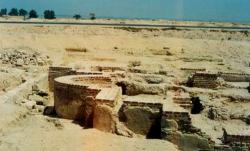 Al-Hammam - The Ministry of State for Antiquities (MSA) has summoned the Tourism and Antiquities Police to face an armed gang which invaded the archaeological site of Al-Hammam, located on the Alexandria-Matrouh Highway. MSA minister Mohamed Ibrahim told Ahram Online on Sunday the gang had marched into the excavation area with machine guns. The site comprises remains of a Graeco-Roman fortress, roads, temples and cemeteries while the excavation area includes remains of a Graeco-Roman bath, a channel for drainage water and huge limestone blocks.
Al-Hammam - The Ministry of State for Antiquities (MSA) has summoned the Tourism and Antiquities Police to face an armed gang which invaded the archaeological site of Al-Hammam, located on the Alexandria-Matrouh Highway. MSA minister Mohamed Ibrahim told Ahram Online on Sunday the gang had marched into the excavation area with machine guns. The site comprises remains of a Graeco-Roman fortress, roads, temples and cemeteries while the excavation area includes remains of a Graeco-Roman bath, a channel for drainage water and huge limestone blocks.
http://english.ahram.org.eg/NewsContent/9/41/91472/Heritage/GrecoRoman/Armed-gang-invade-Egypts-AlHammam-archaeological-s.aspx
CHINE – 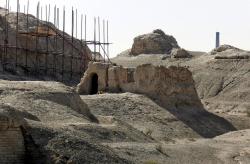 Qigexing - Since 2012, archaeologists have been working on a two-year project at the Qigexing Temple ruins in the Xinjiang Uygur Autonomous region. As an important crossroads on the northern silk road, the site is crucial to study how Buddhism developed in China. After 1700 years of natural erosion and rampaged by war, this is what remains of the Qigexing Buddhist Temple, also know as the"Seven-Stars Buddhist Temple Ruins". Located in the South west of Yanqi, the temple cave compound is believed to have been a major religious center along the northern route of the Silk Road. And archaeologists have been trying decipher its role in spreading Buddhism in China by working underneath the ruins. Wu Weisheng, Director of Yanqi Cultural Relics Institutes, said, "The wall paintings found in this cave are very similar to the ones found in the Kizil Cave. They mainly feature Buddhist jakata. From the architecture and painting styles we hope to see how Buddhism developed in China and how it influenced local cultures." Work conducted at the site in the past few decades has already proven to quite promising with some inspiring discoveries. For example this script discovered in 1975 is the earliest playtext known in China. Unfortunately, most of the cultural relics were looted by foreign explorers in the early 1900s. The two-year long project at Qigexing Buddhist Temple Ruins will end in September and hopefully archaeologists will be able to reveal more to the public about this ancient temple.
Qigexing - Since 2012, archaeologists have been working on a two-year project at the Qigexing Temple ruins in the Xinjiang Uygur Autonomous region. As an important crossroads on the northern silk road, the site is crucial to study how Buddhism developed in China. After 1700 years of natural erosion and rampaged by war, this is what remains of the Qigexing Buddhist Temple, also know as the"Seven-Stars Buddhist Temple Ruins". Located in the South west of Yanqi, the temple cave compound is believed to have been a major religious center along the northern route of the Silk Road. And archaeologists have been trying decipher its role in spreading Buddhism in China by working underneath the ruins. Wu Weisheng, Director of Yanqi Cultural Relics Institutes, said, "The wall paintings found in this cave are very similar to the ones found in the Kizil Cave. They mainly feature Buddhist jakata. From the architecture and painting styles we hope to see how Buddhism developed in China and how it influenced local cultures." Work conducted at the site in the past few decades has already proven to quite promising with some inspiring discoveries. For example this script discovered in 1975 is the earliest playtext known in China. Unfortunately, most of the cultural relics were looted by foreign explorers in the early 1900s. The two-year long project at Qigexing Buddhist Temple Ruins will end in September and hopefully archaeologists will be able to reveal more to the public about this ancient temple.
VIDEO = http://english.cntv.cn/program/cultureexpress/20140113/102344.shtml